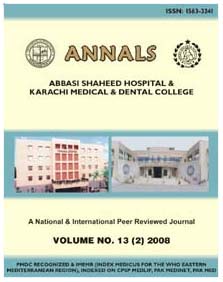| CLINICAL COURSE AND OUTCOME OF VARIOUS
TYPES OF HEPATIC ENCEPHALOPATHY
(AN EXPERIENCE OF 72 CASES AT CHK)
.
Sirajus Salkeen, Khalid Mahmood, Iftikhar Haider Naqvi,
Badar Abbasi, Abu Talib, Tehseen Akhtar
ABSTRACT
Objective
To observe the clinical course of various types of hepatic encephalopathy
(HE) and their outcome.
Patients and Methods
It was a cross sectional hospital based study conducted in medical
unit IV Civil Hospital Karachi and Dow university of Health sciences
from Nov 2007 to June 2008. All patients who were aged 13 or above
presented with symptoms and signs of HE were included whether having
acute or chronic liver disease. After excluding all other causes
of encephalopathy, HE was confirmed by raised serum NH3 levels and
typical EEG pattern. HE was graded clinically according to West
Haven classification. Data of the study was analyzed through SPSS
version 15.0 where mean and SD was applied for continuous variables
while percentages were used for discrete variables.
Results
Out of 72 patients of HE, 76.1% were males with the mean age of
53.35 years. Among types of HE, the type C HE was the most frequent
(85.91%) followed by the type A (15.49%) while no case of type B
was observed. Most common cause for type A HE was acute viral hepatitis
(hepatitis A 45.45%, hepatitis B 27.27% and hepatitis E 18.8%) followed
by fatty liver of pregnancy 9.09% . Type C HE was mainly caused
by chronic viral hepatitis (hepatitis C 78.68%, hepatitis B 27.27%)
followed by autoimmune hepatitis (4.91%), Wilson’s disease
(3.27%) and haemochromatosis (1.63%). Most of the patients (72.72%)
in type A HE were in grade IV hepatic encephalopathy or hepatic
coma while (29.50%) patients of type C HE had hepatic coma or grade
IV hepatic encephalopathy. Twenty two patients expired with an over
all mortality rate of 30.55%. Mortality was even higher in type
A HE due to extensive liver injury, striking cerebral edema, acute
hepatic coagulopathy with bleeding and marked metabolic derangements.
Conclusion
Hepatic encephalopathy with its various types is frequently reported
medical emergency at civil hospital Karachi. Mortality rate was
very high in patients with acute extensive liver damage (type A
HE) than the patients with cirrhosis (type C HE). Early diagnosis
and prompt treatment in case of extensive liver injury can reduce
mortality in type A HE. Whereas patient education, comprehensive
counseling for early recognition of precipitating factors and strict
follow up is recommended to reduce mortality in type C HE.
Key words
Hepatic encephalopathy (HE), acute Fulminant hepatic failure (AFHF),
disseminated intra vascular coagulation (DIC), acute respiratory
distress syndrome (ARDS)
|

